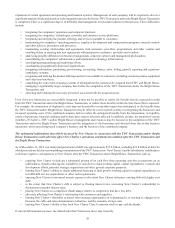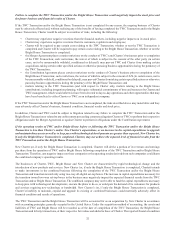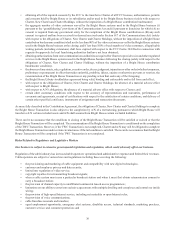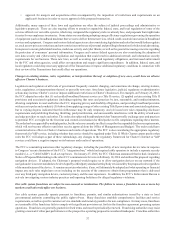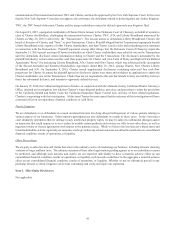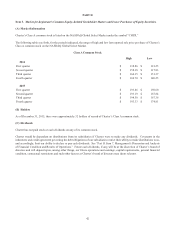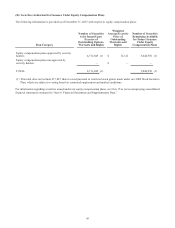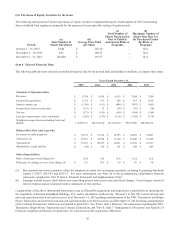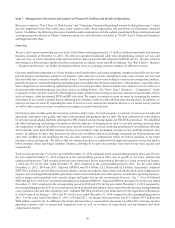Charter 2015 Annual Report Download - page 54
Download and view the complete annual report
Please find page 54 of the 2015 Charter annual report below. You can navigate through the pages in the report by either clicking on the pages listed below, or by using the keyword search tool below to find specific information within the annual report.39
are extremely complex and subject to varying interpretations. There can be no assurance that our tax positions will not be challenged
by relevant tax authorities or that we would be successful in any such challenge.
Further regulation of the cable industry could impair our ability to raise rates to cover our increasing costs, resulting in
increased losses.
Currently, rate regulation of cable systems is strictly limited to the basic service tier and associated equipment and installation
activities, and the FCC recently revised its rules, in response to changed market conditions, to make it more difficult for local
franchising authorities to assert rate regulation authority. However, the FCC and Congress continue to be concerned that cable
rate increases are exceeding inflation. It is possible that either the FCC or Congress will further restrict the ability of cable system
operators to implement rate increases for our video services or even for our high-speed Internet and voice services. Should this
occur, it would impede our ability to raise our rates. If we are unable to raise our rates in response to increasing costs, our losses
would increase.
There has been legislative and regulatory interest in requiring companies that own multiple cable networks to make each of them
available on a standalone, rather than a bundled basis to cable operators, and in requiring cable operators to offer historically
bundled programming services on an á la carte basis to consumers. While any new regulation or legislation designed to enable
cable operators to purchase programming on a standalone basis could be beneficial to Charter, any regulation or legislation that
limits how we sell programming could adversely affect our business.
Actions by pole owners might subject us to significantly increased pole attachment costs.
Pole attachments are cable wires that are attached to utility poles. Cable system attachments to investor-owned public utility poles
historically have been regulated at the federal or state level, generally resulting in favorable pole attachment rates for attachments
used to provide cable service. In contrast, utility poles owned by municipalities or cooperatives are not subject to federal regulation
and are generally exempt from state regulation. Future regulatory changes in this area could impact the pole attachment rates we
pay utility companies.
Changes in channel carriage regulations could impose significant additional costs on us.
Cable operators also face significant regulation of their video channel carriage. We can be required to devote substantial capacity
to the carriage of programming that we might not carry voluntarily, including certain local broadcast signals; local public,
educational and governmental access (“PEG”) programming; and unaffiliated, commercial leased access programming (required
channel capacity for use by persons unaffiliated with the cable operator who desire to distribute programming over a cable system).
The FCC adopted revised commercial leased access rules which would dramatically reduce the rate we can charge for leasing this
capacity and dramatically increase our administrative burdens, but these remain stayed while under appeal. Legislation has been
introduced in Congress in the past that, if adopted, could impact our carriage of broadcast signals by simultaneously eliminating
the cable industry’s compulsory copyright license and the retransmission consent requirements governing cable’s retransmission
of broadcast signals. The FCC also continues to consider changes to the rules affecting the relationship between programmers
(including broadcasters) and multichannel video distributors. Future regulatory changes could disrupt existing programming
commitments, interfere with our preferred use of limited channel capacity, increase our programming costs, and limit our ability
to offer services that would maximize our revenue potential. It is possible that other legal restraints will be adopted limiting our
discretion over programming decisions.
Our voice service is subject to regulatory burdens which may increase, causing us to incur additional costs.
We offer voice communications services over our broadband network using VoIP services. The FCC has ruled that competitive
telephone companies that support VoIP services, such as those we offer our customers, are entitled to interconnect with incumbent
providers of traditional telecommunications services, which ensures that our VoIP services can compete in the market. The scope
of these interconnection rights are being reviewed in a current FCC proceeding, which may affect our ability to compete in the
provision of voice services or result in additional costs. The FCC has also declared that certain VoIP services are not subject to
traditional state public utility regulation. The full extent of the FCC preemption of state and local regulation of VoIP services is
not yet clear, and at least one state (Minnesota) has asserted jurisdiction over the company’s VoIP services. We have filed a legal
challenge to that jurisdictional assertion, which is now pending before a federal district court in Minnesota. Telecommunications
companies generally are subject to other significant regulation which could also be extended to VoIP providers. If additional
telecommunications regulations are applied to our VoIP service, it could cause us to incur additional costs. The FCC has already
extended certain traditional telecommunications carrier requirements to many VoIP providers such as us, including E911, Universal
Service fund collection, CALEA, privacy of Customer Proprietary Network Information, number porting, network outage reporting,


